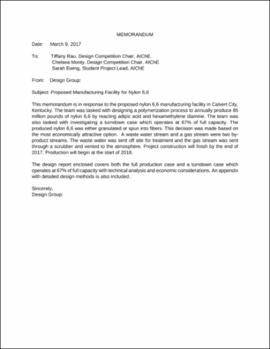| dc.contributor.author | Johns, Austin | |
| dc.contributor.author | Jones, Caleb | |
| dc.date.accessioned | 2017-10-10T20:54:18Z | |
| dc.date.available | 2017-10-10T20:54:18Z | |
| dc.date.issued | 2017-03-09 | |
| dc.identifier | oksd_JohnsJones_HT_2017 | |
| dc.identifier.uri | https://hdl.handle.net/11244/52258 | |
| dc.description.abstract | The purpose of this project was to design an economically viable process that produces 85 million pounds of nylon 6,6 annually. This process would be carried out in a new plant that would be built in the Calvert City, Kentucky area. The full capacity fiber design achieves this production goal and produces nylon 6,6 with a number average molecular weight of 2635 amu and an average degree of polymerization of 23.3 monomers per molecule. | |
| dc.description.abstract | The production of nylon 6,6 fibers was determined to be more economically attractive than granular nylon 6,6 due to its much larger net present value (NPV) of approximately $174 million compared to the granular NPV of negative $190 million. The production of nylon 6,6 fibers had a discount cash flow rate of return (DCFROR) of 243% and a discounted payback period of only 6 months. The production of nylon 6,6 fibers is still economically attractive and physically feasible under turndown conditions with an NPV of approximately $98 million, a DCFROR of 145%, and a discounted payback period of 10 months. The turndown period does have a slightly higher cost of manufacturing per pound of nylon 6,6 produced, costing $1.59 per pound as opposed to the $1.51 per pound that full scale production costs. It is recommended that the design to produce nylon 6,6 fiber is carried forward to the detailed design stage and operated at full capacity. | |
| dc.description.abstract | The reaction was simulated in Polymath using two key assumptions. The reaction was carried out at 72.5 psig and 622 degrees F while the vapor pressure of water under these conditions was greater than 1400 psig. This discrepancy in reactor pressure and vapor pressure led to the assumption that the water produced by the condensation polymerization reaction and the water introduced by the feed stream instantly vaporizes and it is vented from the reactor. HMDA is significantly less volatile than water and was assumed to be non-volatile under reaction conditions. The 72.5 psig reaction pressure was chosen to help justify this assumption without impacting capital costs significantly. Further investigation into these two assumptions and the effects of deviations from the simulation model are recommended. | |
| dc.format | application/pdf | |
| dc.language | en_US | |
| dc.rights | Copyright is held by the author who has granted the Oklahoma State University Library the non-exclusive right to share this material in its institutional repository. Contact Digital Library Services at lib-dls@okstate.edu or 405-744-9161 for the permission policy on the use, reproduction or distribution of this material. | |
| dc.title | Proposed manufacturing facility for nylon 6,6 | |
| osu.filename | oksd_JohnsJones_HT_2017.pdf | |
| osu.accesstype | Open Access | |
| dc.type.genre | Honors Thesis | |
| dc.type.material | Text | |
| thesis.degree.discipline | Chemical Engineering | |
| thesis.degree.grantor | Oklahoma State University | |
